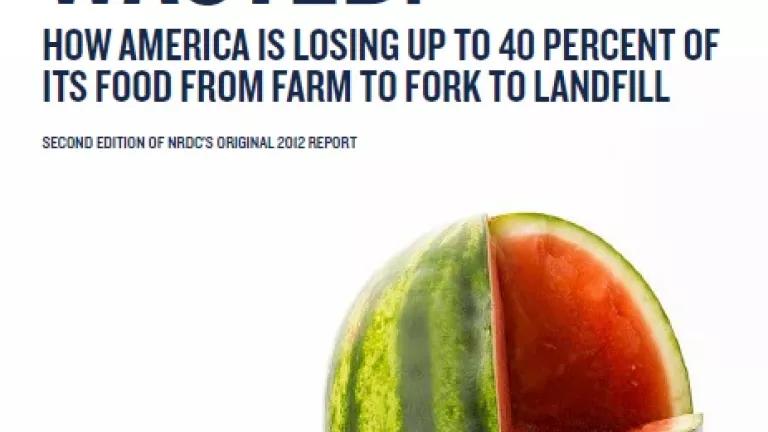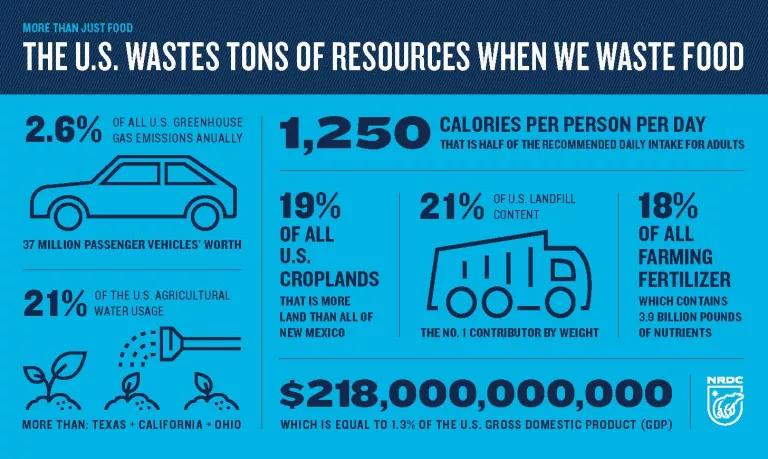WASTED: Second Edition of NRDC’s Landmark Food Waste Report

Food waste occurs at all levels of the supply chain. We leave entire fields unharvested, reject produce solely for cosmetic reasons, throw out anything past or even close to its “use by” date, inundate restaurant patrons with massive portions, and let absurd amounts of food rot in the back of our fridges.
Wasting food is not only expensive, it’s also an environmental tragedy because of the enormous loss of natural resources that were used to get food from seed to the table. A staggering amount of climate pollution, cropland, water, fertilizer, labor, and energy goes into producing all that uneaten food, which ultimately adds up to a fifth of everything that’s thrown into landfill.
In 2012, NRDC helped spark a national dialogue about the alarming amount of food that goes to waste in our country when we released Wasted: How America is Losing Up to 40 percent of Its Food from Farm to Fork to Landfill. In the intervening five years, we have started to lay the foundation to address this colossal problem, but much work remains. And we felt the time has come for an update.
Today, we’re releasing a second edition of that report which captures the latest studies, success stories, and recommendations across the food system. It provides updated statistics on the environmental, economic and social impacts, analyzes areas of progress at the government, business and consumer levels in the last five years, and offers policy solutions for overcoming the problem.
Among other things, it reveals that, across the food system, America throws out more than 400 pounds of food per person per year. And when that food is wasted, so are the resources that go into producing it, including 21 percent of freshwater used by the U.S. agricultural industry. Wasted food also generates climate change pollution equivalent to 37 million cars per year. If we could redirect just one-third of the food that we now toss to people in need, it would more than cover unmet food needs across the country.

But the updated report also shows that there’s lots to celebrate. In the past five years we have made progress in a number of areas:
- POLICY: We’ve seen a range of significant policies passed. In September 2015, both the United Nations and the U.S. federal government embraced goals to cut food waste 50% by 2030. Many states have incentivized food donation to hungry people. And the U.S. Department of Agriculture issued new guidance to standardize food date labels—which are a major source of consumer confusion and waste.
- INDUSTRY: Businesses at all stages of the food system have made commitments to reduce wasted food in their operations, recognizing the benefit to their bottom line. Especially notable, a major consortium of more than 400 retailers and manufacturers committed to cutting their food waste in half by 2025.
- CONSUMERS: The largest source of food waste is people in their own homes, who waste more than grocery stores, restaurants or any other single part of the supply chain. Fortunately, a 2016 public opinion poll by the Ad Council revealed that 74% of respondents reported that food waste was important to them. An NRDC public service campaign with the Ad Council, called Save The Food, also launched last year to help raise consumer awareness—and we just released a second phase of the campaign today.
However, there’s a lot of work that remains to be done. For one, data are still limited and it is difficult to assess whether we are actually wasting less food than when our first Wasted report was published in 2012. We need more comprehensive data to better understand how much we’re wasting and how we can improve.
Additionally, further policy changes are needed to prevent food waste—such as food date labelling legislation—and to remove barriers and expand liability protections for food donation. More infrastructure is also needed to expand recycling options for food scraps.
In many instances, improved technological solutions, redesigned products or optimized purchasing standards could reduce inefficiencies that lead to wasted food. Many of these solutions are best practices that can be implemented simply by streamlining standard operating procedures. Because small actions add up to a big problem, it’s also true that small actions can contribute to fixing the problem. Each of us—federal and state legislators, food processors, retailers, restaurant owners, and every single home cook—can take meaningful steps to change our habits and save food, money, water, energy and land from going to waste.
Our second edition of Wasted highlights a path forward.




.jpeg.jpg?h=8ff71c51&itok=jRVQcaG9)